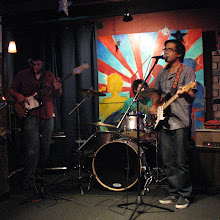 |
| Paul Kossoff (Free) and his dual Marshall 1959 model 100 watt stacks. Much too loud for my gigs, but his tone is incredible. |
I started off with a Weber 6m45p amp head kit and modified the circuit as I went along. So what I ended up with was roughly a cross between the Marshall 50 watt Lead model 1987 and the later 2204, possibly an amp that never really existed: dual KT66 output tubes (instead of the usual EL34), 12AT7 phase inverter (30% less gain than the usual 12AX7), with some capacitor changes that were more similar to the mid '70s Marshal Master Volume model 2204, yielding a somewhat brighter sound just without the increased gain, and the all important post phase inverter master volume (PPIMV) that would allow me to dial in any gain level at any volume. I loved the sound of the amp; it was very dynamic and open sounding, with a creamy, smooth breakup that was more akin to the mid 1960's Marshall 1987 than the 2204. When playing a Les Paul, the sound was very similar to Paul Kossoff's tone on "Alright Now," especially when played through a 4x12 cab with Celestion Greenbacks (which I no longer own), but when paired with the Jazzmaster, it was a unique tone all my own. It was great!
 |
| Me and the amp at the Golden West College Battle of the Bands, April 2012. The cab is a home made open back 2x12 with two Fender OEM Eminence speakers pulled from a Fender Twin. |
The amp was fail proof for five years, logging hundreds of hours of shows, recording sessions, and rehearsals. It was all good until three weeks ago when the amp went POOF! in the middle of recording a guitar solo for the Short Term Melody's upcoming album.
It literally sounded like someone was frying bacon in the middle of the guitar solo, then a quickly diminishing output. Then the smell of burned capacitors (like burning plastic)... OH SHIT was all I thought. After I let the amp cool down I pulled the chassis from the cabinet. Everything looked fairly normal except some of the caps were leaking an oily fluid from them. Upon further examination, the power tubes and the mains fuse had indeed burned out.
So began the journey to get my sick amp back to health again.

No comments:
Post a Comment